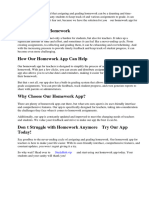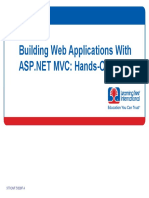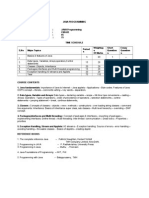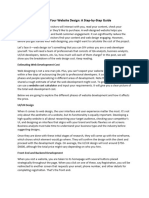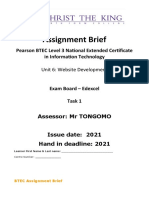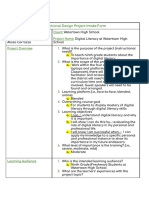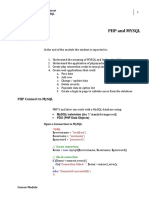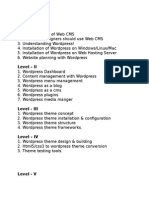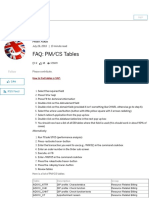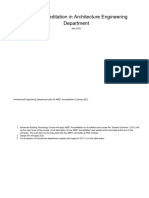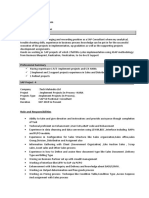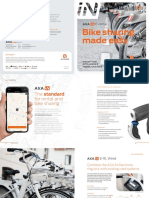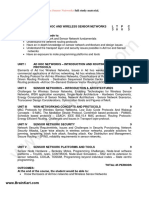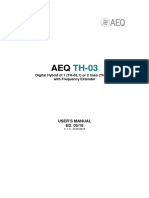The process of developing the website
Create website is a complex process. Before the start of the process it is necessary to establish
the basic objectives and strategy of the website:
What is the mission of your organization?
How website will serve the mission of the organization?
What are the two or three main goals of creating the site?
Who is the site aimed at? Who are the people who will visit it?
What would you like to site users think or do after visiting your website?
How will you measure the success of the site?
Form and function of website directly depend on these questions. Only when you are able to
accurately answer all the questions, you can begin creating the site. The process of
developing the website is done in six main phases:
1. Defining the site and planning
2. Information architecture
3. Site design
4. Site construction
5. Site marketing
6. Site maintenance
1. Defining the site and planning
In the initial phase of the website, it is necessary to answer the following questions:
Who constitutes the team for creating the website - people from the company,
outsourced people or a combination of both?
Who is the project leader (the person responsible for managing the process of
creating a website)?
Who is responsible for cooperation with external partners?
Who will be the editor of the website when it's finished?
What operating systems (Windows, Mac OS X, UNIX, Linux ...) and browser
(MS Internet Explorer, Mozilla Firefox, Safari, Opera, Chrome ...) will support the
site?
What is the connection to the Internet of an average user site - 56Kbit / s modem,
ISDN, ADSL, LAN?
What technology will be used on the site - HTML, Java, JavaScript, CGI, ASP,
CSS, Flash, Shockwave, QucikTime, Real Media, Windows Media, databases,
search the site?
Do we need to install additional plugin in order to view the site content?
What standards of data protection and traffic on the site will be used?
Where will the site be located - on your own web server or internet server
provider?
How will be collected the official statistics of visits of the site?
How will users of the site contact technical support - e-mail, forum, chat, phone?
1
� Who and what are the costs of creating the site?
2. Information architecture
At this stage it is necessary to make:
Detailed specification of site design
A detailed description of the site's content
Site Map
Sketch website
Timelines site development
Several pilot designs (rough draft) of the site
3. Site design
At this stage it is necessary to:
Develop a detailed organizational chart site
Develop specification of the graphic design for all types of pages on the site
Make an example ("template") for all types of pages on the site
Prepare text for the website
Prepare images, illustrations and animations that will appear on the site
Create a database and a proposal for connecting to the site
Conduct of the work relating to the programming
4. Site construction
At this stage, it is expected that the following matters have been completed:
HTML code for your pages
The database and its connection with the site
Programming
The content (text, photographs, illustrations, animations, sound ...) the whole site
is set
Last check proofreaders
Testing Site
Archive the finished site and the entire material that was used when creating
5. Site marketing
The fact that you made a website does not mean that visitors will come spontaneously. This
fallacy is known as the "field of dreams". You must in some way make it clear that your site
exists and that they can be used.
There are several mediums by which you can make site promotion:
2
� Other websites (banners, stamps, text links ...)
Search engines
Print media (newspapers, magazines)
Television and radio
Posters and billboards
Material of the company (letterheads, business cards, notepads, product
packaging, instructions for use of the product, press releases, transport ...)
Your website can be used as a space for publication of advertisements of other websites or
companies. This will increase the revenue that your site provides, but it may annoy users. It is
necessary to strike a balance between the needs of users on the one hand and the possibility
of making a profit on the other. In that will help the research results from the 2013th year on
which the design elements of Internet users at least like (ie, the most hated!)
Elements of design Percentage who responded with
"Very negative" or "negative"
Pop-up windows 95%
Slow loading of site 94%
Website tries to trick you into clicking on a link 94%
No button to close the web site 93%
It covers part of the site that you want to see 93%
It is not clear what it is for 92%
Content layout is changing 92%
It occupies most of the site 90%
Blinks 87%
Automatically play sound 79%
The list of most wanted terms in different search engines can be found at the following URL:
Google Zeitgeist
http://www.google.com/press/zeitgeist.html
Lycos 50 with Dean
http://50.lycos.com/
Yahoo! Buzz Index
http://buzz.yahoo.com/
Also, it will be interesting websites with statistics on trends in user behavior on the Internet,
search engines and web sites.
Clickz Stats
http://www.clickz.com/stats/
eMarketer
http://www.emarketer.com
Search Engine Watch
http://www.searchenginewatch.com
3
�6. Site maintaining
After the site is created, it needs to be maintained. Regularly updated site is crucial to its
success. It is necessary to choose a team that will be responsible for updating the website and
share their responsibilities. It is necessary to appoint a editor (webmaster) - a person who will
be responsible to manage this process.
In this phase, it is necessary to regularly backup the content of the website (backup), as in the
case of possible damage to the web server to prevent loss of contents






